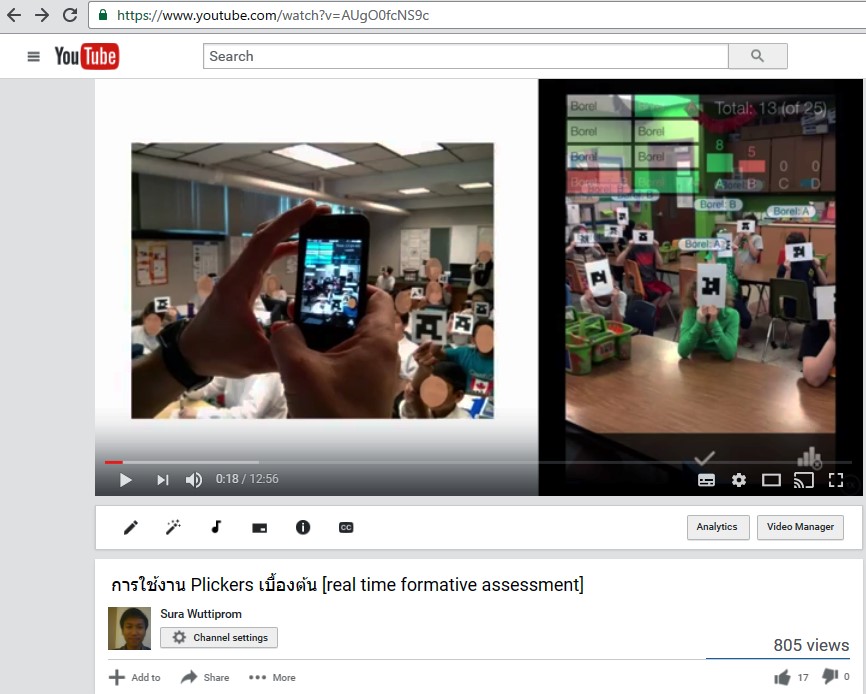Plickers: เครื่องมือประเมินเพื่อการเรียนรู้แบบเรียลไทม์สำหรับห้องเรียนที่มีข้อจำกัดเรื่องเทคโนโลยี
Main Article Content
Abstract
Sura Wuttiprom, Khandhi Toeddhanya and Karntarat Wuttisela
รับบทความ: 10 มกราคม 2560; ยอมรับตีพิมพ์: 12 ตุลาคม 2560
บทคัดย่อ
หลังจากที่ Eric Mazur พัฒนารูปแบบการจัดการเรียนรู้แบบปฏิสัมพันธ์สำหรับห้องเรียนที่มีผู้เรียนจำนวนมากในระดับมหาวิทยาลัยที่เรียกว่า peer instruction รูปแบบการจัดการเรียนรู้ดังกล่าวก็ได้รับความนิยมเนื่องจากช่วยทำให้ผู้เรียนมีความเข้าใจในเนื้อหาฟิสิกส์มากยิ่งขึ้น หัวใจสำคัญของการจัดการเรียนรู้แบบ peer instruction คือระบบการจัดการโต้ตอบในชั้นเรียน (classroom respond system) ระหว่างผู้สอนกับผู้เรียนผ่านชุดคำถามแบบเลือกตอบที่เรียกว่า ConcepTest® ในระยะแรกผู้เรียนใช้แผ่นกระดาษที่มีตัวอักษร A B C และ D เพื่อแสดงคำตอบของผู้เรียน แต่ปัญหาหลักของการใช้แผ่นตัวอักษรคือต้องใช้เวลาประมาณ 2 – 3 นาทีในแต่ละครั้งเพื่อนับคำตอบของผู้เรียน ซึ่งในการนับแต่ละครั้งจะได้ข้อมูลในส่วนของภาพรวมเท่านั้น คือ ทราบว่าก่อนและหลังผู้เรียนปรึกษากันมีจำนวนผู้เรียนที่เลือก A B C และ D อย่างละกี่คน และด้วยเวลาในชั้นเรียนที่จำกัด จึงทำให้การสอนแบบ peer instruction ต้องใช้เวลาส่วนหนึ่งไปกับการนับคำตอบร้อยละ 10 – 15 ของเวลาเรียน ต่อมาได้มีการพัฒนาระบบการจัดการโต้ตอบในชั้นเรียนระหว่างผู้เรียนกับผู้สอนขึ้นเรียกว่า Clicker ที่สามารถบันทึกและแสดงผลการตอบของผู้เรียนได้ทันที Clicker 1 ชุด ใช้ได้กับผู้เรียน 32 คน ราคา 28,748 บาท หากผู้เรียน 50 – 60 คน ราคาจะอยู่ที่ 57,496 บาท เนื่องจากข้อจำกัดดังกล่าว ปัจจุบันจึงได้มีการพัฒนาฟรีแอพพลิเคชันบนโทรศัพท์มือถือที่เรียกว่า Plickers ขึ้นมา โดย Nolan Amy สามารถใช้ได้กับผู้เรียนมากถึง 63 คน Plickers ทำงานได้โดยการสแกนแผ่น QR-Code ด้วยโทรศัพท์มือถือที่มีสัญญาณอินเตอร์เน็ต ดังนั้น Plickers อาจเป็นเครื่องมือหนึ่งที่จะได้รับความนิยมอย่างแพร่หลาย
คำสำคัญ: Plickers Peer Instruction ระบบการจัดการโต้ตอบในชั้นเรียนแบบเรียลไทม์
การประเมินเพื่อการพัฒนาที่แสดงผลการประเมินทันที
Abstract
After Eric Mazur has proposed interactive teaching method in large class university environment namely peer instruction, it has become favored in general because the instruction helped students got more understanding in physics. The basis of peer instruction is the classroom respond system (CRS) by using a set of multiple choice questions relates to concepts which is called ConcepTest®. Initial students used flash cards which have got the letters A, B, C and D. However, the problem for using lettered sheets is that a lecturer has to spend 2 – 3 minutes on each quiz for counting a number of students’ answers. For each counting, a lecturer gets only the holistic view of a poll on students’ answers which clarifies the result – how many students choose on A, B, C and D before and after peer discussions. By using it, class time is limited, and it has been used for counting a number of students’ answers. It means peer instruction can use about 10 – 15 percentage of classroom time for this purpose. Later, the CRS called Clicker has been developed to be able to record and display the answers immediately. The clickers cost about THB 28,748 (For 32 pieces). If the class has 50 – 60 students, it will cost about THB 57,496. At present, there is a free application which is called Plickers developed by Nolan Amy. The Plickers can be used as Clickers, but it doesn’t require devices except smartphone. The Plickers can be used up to 63 students with working with sheets of QR-code paper and only one smartphone with internet signal. Therefore, the Plickers can be widespread to any schools.
Keywords: Plickers, Peer instruction, Real-time classroom respond system, Quick formative assessment
Downloads
Article Details

This work is licensed under a Creative Commons Attribution-NonCommercial 4.0 International License.
References
Amy, N., and Kim, J. (2016). Plickers.
Bruff, D. (2017, January). Classroom response systems (“Clickers”). Vanderbilt Center for Teaching. Retrieved from https://cft.vanderbilt.edu/guides-sub-pages/clickers/
Caldwell, J. E. (2007). Clickers in the large classroom: Current research and best-practice tips. CBE-Life Sciences Educ-ation 6(1): 9–20.
Chalermchat, S., and Wuttiprom, S. (2015). Effect of peer instruction on pattern analysis of grade-10 students’ conceptual understanding about force and motion. Journal of Research Unit on Science, Technology and Environment for Learning 6(2): 232–242.
Deslauriers, L., Schelew, E., and Wieman, C. (2011). Improved learning in a large-enrollment physics class. Science 332 (6031): 862–864.
Mazur, E. (1997). Peer instruction. Upper Sad-dle River, NJ: Prentice Hall.
